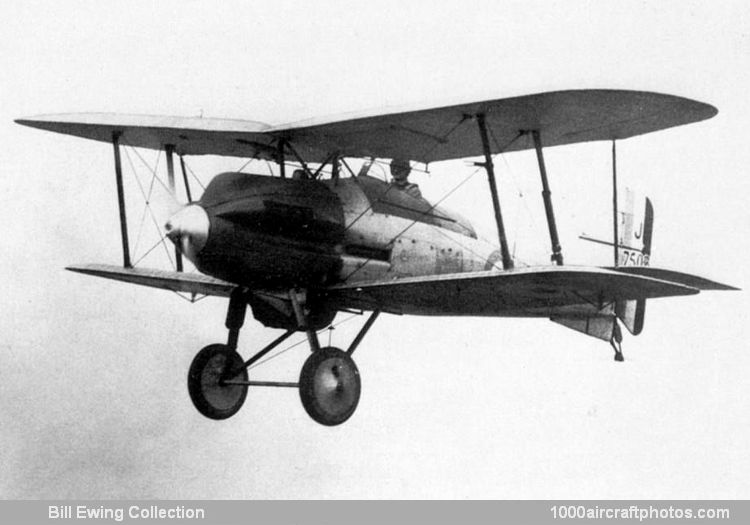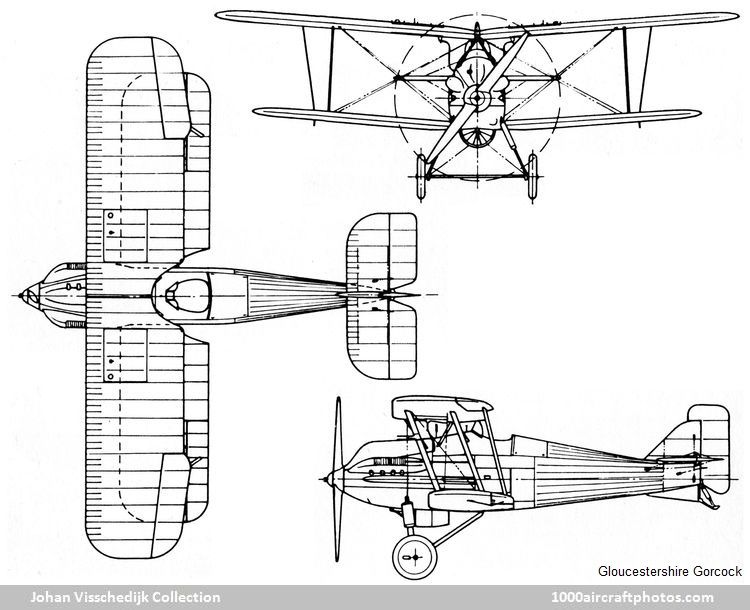In May 1924 Gloucestershire Aircraft received a contract from the Air Ministry for three (s/n J7501 to J7503) experimental single-seat fighters to be powered with the Napier Lion engine. Two aircraft were to have a steel fuselage and wooden wings, and the third was to be all-steel. Design work began in the following month, but a major part of the company's design effort was being concentrated on the Gamecock and, to a lesser extent, on development of the Gloucestershire Aircraft II racer, and this limited the design progress on the Gorcock.
It was therefore more than a year before the first aircraft (J7501), was completed. In appearance it strongly resembled the Gamecock, but the exceptionally neat installation of the 450 hp geared Napier Lion IV, the pointed spinner and the manner in which the three cylinder banks were faired into the fuselage gave an overall impression of sleekness which clearly stemmed from the racers. The two fuel tanks in the upper wings were specially contoured to the wing shape and projected only a small amount below the undersurface, and a Grebe-type tail unit was fitted initially before reverting to the more familiar Gamecock design.
At that time the Air Ministry was considering the relative merits of geared and direct-drive engines, and in order to gain comparative performance figures from the two types of engine the second Gorcock (J7502) was powered by a 525 hp direct-drive Lion VIII. In addition these two wooden-winged aircraft were used initially to flight test different types of radiators. Gloucestershire Aircraft's experimental department had considerable difficulty in getting all three banks of the Lion's cylinders to fire evenly, and engine running was carried out after dark so that the color of the exhaust flame could be checked; a cure was effected by cutting back the air intake pipes at different angles. As a result of these delays the first two Gorcocks were not delivered until 1927.
Design of the all-metal Gorcock (J7503) with a geared Lion IV, did not begin until mid-1925 and construction was not completed until June 1927, delivery being soon afterwards. All three aircraft were heirs to the Gamecock's wing flutter, but additional struts were subsequently added to brace the upper mainplane overhang, and narrow-chord ailerons were fitted.
Although the Gorcock was not ordered into production, these three prototypes were used for research and development flying by the company and the RAE Farnborough for a considerable period. In 1929, for example, a series of tests were put in hand on three types of duralumin propellers on J7502. An unusual feature of the Gorcocks was that despite their research flying role each carried two machine guns.
The photo is showing J7502 fitted with a modified cowling for flush exhaust pipes, rearward carburetor air intakes, a D-shaped radiator, Gamecock-type tail unit and re-styled top decking aft of the cockpit. J7502 was lost in a crash at Farnborough in May, 1931, the following data relate to this aircraft.
Description: Experimental single-seat fighter biplane. All-metal construction, or metal fuselage with wooden wings, with fabric covering.
Accommodation: Pilot in open cockpit.
Power plant: One 525 hp Napier Lion VIII twelve-cylinder liquid-cooled direct-drive broad-arrow engine, driving a 9 ft 2 in (2.79 m) diameter two-blade fixed-pitch wooden or metal propeller (J7502). Fuel 71.8 gal (272 l); oil 6.6 gal (25 l).
Armament: Two fixed synchronized Vickers 0.303 in (7.7 mm) machine guns mounted in troughs in the fuselage sides. Provision for racks to carry four 20 lb (9 kg) bombs beneath the lower wings."

